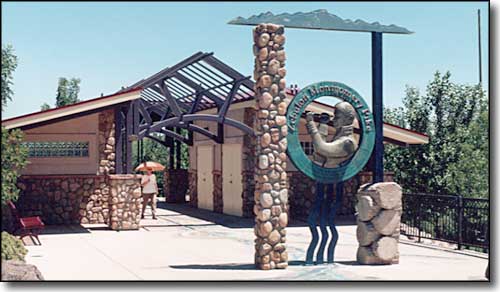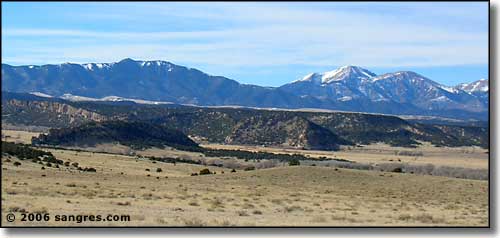 |
Zebulon Pikeand the Search for the Source of the Red River |
|
|
|
In 1803 the United States made the Louisiana Purchase and President Thomas Jefferson sent Meriwether Lewis and William Clark on their famous mission to find out just what we got for our money. Lewis & Clark and their Corps of Discovery spent two years planning and staging before starting up the Missouri River. They spent the next 3 years making their way into the history books. They explored a lot of the northern part of the Purchase by making the journey to the Pacific coast and then back again to St. Louis. They did a great job of mapping and sorting out a lot of the geography along the way. But Lewis and Clark stayed completely away from the southern boundary of the Purchase. |
|
|
|
In 1806, Jefferson sent Lt. Zebulon Pike with a company of soldiers to chart that southern boundary by following the Arkansas River to its' source. Once there, he was to head south and locate the headwaters of the Red River, then follow that river back to Louisiana. On their way out of Missouri, the expedition was also given the task of escorting 51 Osage Indians back to their homes in Kansas. On July 15, 1806, Pike and crew sailed from a landing 14 miles north of St. Louis on the Missouri River and headed west. Five weeks later they arrived at a village of the Little Osage and had a meeting with the chiefs of the tribe. One aspect of Pike's mission was to establish peaceful relationships with different tribes and encourage them to trade with the Americans. After two weeks of negotiations, Pike and his men moved on, looking for the Pawnee Nation villages. After three weeks, the Pawnee were found and another week of negotiations happened. According to Pike's notes, he smoked the pipe of peace with Pawnee, Osage and Kansas Indians and felt he was doing pretty good until it came time to leave. That's when he discovered the Pawnee didn't want him to go any further west. After a show of force, Pike and company were allowed to move on. |
 The Zebulon Pike Memorial at the Arkansas Riverwalk in Pueblo |
|
Eleven days later they found the Arkansas River and set up camp for a few days. Here they hunted and stored up meat while some of the men constructed two canoes. Then they headed upstream. Two weeks journey (about 15 miles per day) brought them to their first view of the "Mexican Mountains," (the Front Range around Pike's Peak). A few days later they built a breastworks near the confluence of Fountain Creek and the Arkansas River. From here, Pike, Doctor Robinson and Privates Miller and Brown set out to climb Pike's Peak. They didn't make the summit, having grossly under-estimated the difficulty and the distance involved. They returned to camp after a week's absence and then the whole party headed upstream along the Arkansas. When they came to the Royal Gorge, they tried to find some other way west. At this point they began a series of journeys that basically, led them in circles. Finally, they came to the Arkansas again (although they thought it was the Red River). From here, Pike and a couple of his men went north to locate and map the headwaters of the river while the rest of the party went south. Four days later Pike returned to the main group and they spent Christmas somewhere near where Salida is now. Thinking they were now following the Red River and the main part of their mission was accomplished, they started moving back downstream. Then they came to the Royal Gorge again and realized their mistake. From here they turned south and fought their way up the canyon of Grape Creek and entered the Wet Mountain Valley. |
 Medano Pass is in that saddle in the mountain ridge |
|
Early January, heavy winter, the Wet Mountain Valley: these guys weren't prepared. For twelve days, they slowly made their way south, looking for a way to go west through that great wall of mountains we call the Sangre de Cristo's. We don't know for sure if they made their way through Medano Pass or through Mosca Pass, a bit further south (both passes cross the spine of the mountains between Huerfano County and Alamosa County), but we know they emerged from the mountains at the edge of the Great Sand Dunes on January 28, 1807. They were in the San Luis Valley in the heart of winter. They were really not prepared for it (although they fared better than John Fremont would almost forty years later in the same valley). Native Americans had more sense than to be in the Valley in the heart of winter but these American soldiers trudged on into the cold and snow. For five days they travelled south in the valley, crossing the Rio Grande and continuing until they came to the Conejos River at a place where warm springs flowed out of the ground and kept the river free of ice right there. This is where they built Pike's Stockade (just north of Manassa) and prepared to last out the winter. On February 7, Doctor Robinson headed out on his own to visit Santa Fe. On the 16th, a Spanish dragoon in the company of an Indian arrived and invited Pike to come to Santa Fe. He respectfully declined, saying that his men had been scattered all over the countryside and were now returning to continue their journey back to Louisiana. On the 26th, a company of dragoons arrived and set about "inviting" Pike to accept the Governor's hospitality and visit with him in Santa Fe. On the 28th, Pike and most of his men left camp with the Spaniards and headed for Santa Fe. This is where the formal Pike Expedition ended. In Santa Fe, Pike's baggage was searched and Governor Allencaster inspected Pike's commission and orders. Then Pike and his men were taken to Chihuahua, Mexico, to meet with His Excellency, Commandant General Salcedo, where Pike's papers and records were again inspected and reviewed. Pike says that never was he formally under arrest on this journey and he was actually able to learn quite a bit about the military forces and the geography, and about the political sentiments and dispositions of the local people he met along the way. The Spanish returned Pike and his men to Natchitoches, Louisiana on July 1, 1807. In 1810 he published his final report of the expedition as a book. It was filled with much valuable information and was widely read. But Pike never did locate the headwaters of the Red River. |
|
|
| Our History & Heritage |
 |
| Index - Arizona - Colorado - Idaho - Montana - Nevada - New Mexico - Utah - Wyoming National Forests - National Parks - Scenic Byways - Ski & Snowboard Areas - BLM Sites Wilderness Areas - National Wildlife Refuges - National Trails - Rural Life Sponsor Sangres.com - About Sangres.com - Privacy Policy - Accessibility |
| Photos courtesy of Sangres.com, CCA ShareAlike 3.0 License. Text Copyright © by Sangres.com. All rights reserved. |